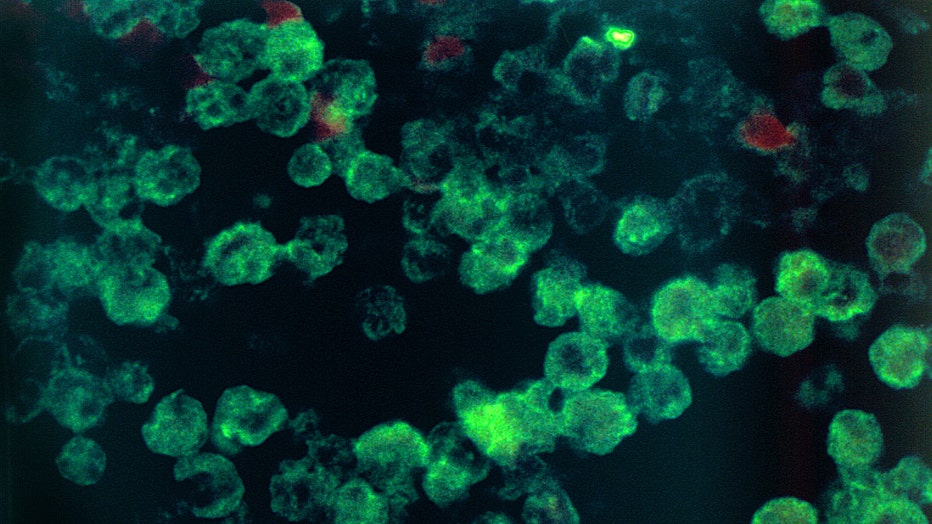Health officials rule out suspected 'Brain-eating amoeba' case in Arizona: Here's what to know
PHOENIX - News surrounding a suspected case of illness that is believed caused by the so-called "brain eating amoeba" made headlines in Arizona in recent day.
On Oct. 24, officials with the Arizona Department of Health Services said they, along with Mohave County officials, are working jointing on a suspected case of infection. A day later, however, officials said the suspected case came back negative.
While there are no confirmed cases of "brain eating amoeba" cases in Arizona, the state has seen cases of infections in the past.
Here's what to know about the serious infection.
What happened exactly?
According to officials with AZDHS, samples were sent to the Centers for Disease Control and Prevention for testing on Oct. 24.
A day later on Oct. 25, results for the samples came back negative, according to health officials.
What is the "brain-eating amoeba?"

Under a magnification of 630X, and implementing a the direct fluorescent antibody (DFA) staining technique, this photomicrograph depicts histopathologic characteristics associated with a case of amebic meningoencephalitis due to Naegleria fowleri par
According to the CDC's website, the "brain-eating amoeba" is a common name for the Naegleria fowleri amoeba.
Naegleria fowleri, according to the website, is the only species of the Naegleria amoeba that infects people. Naegleria is described by the CDC as a free-living amoeba. The organism is so small that it can only be seen with a microscope.
The Naegleria fowleri amoeba, according to the CDC, can be found in the following areas:
- Warm fresh water, like lakes and rivers
- Naturally hot (Geothermal) water, like hot springs
- Untreated naturally hot (Geothermal) drinking water sources
- Warm water discharge from industrial plants or power plants
- Swimming pools, splash pads, surf parks, or other venues that are poorly maintained or don't have enough chlorine in them
- Tap water
- Water heaters
- Soil, including sediment at the bottom of lakes, ponds and rivers
The amoeba, according to CDC officials, is not found in salt water, like the ocean. It grows best at high temperatures up to 115F (~46C), and can survive for short periods at higher temperatures.
According to the Illinois Department of Public Health's website, cases of Naegleria fowleri have, on very rare occasions, happened when people were submerging their heads during religious practices, or irrigating their sinuses using contaminated tap water.
How does it infect humans?
According to the Illinois Department of Public Health, Naegleria fowleri causes a rare, but nearly always fatal disease called Primary Amebic Meningoencephalitis (PAM).
The infection, according to the website, is caused by the amoeba traveling to the brain after entering a human body through the nose. In the brain area, the amoeba destroys brain tissue, and causes swelling and death.
What are the symptoms of PAM?
On the Children's Hospital of Philadelphia's website, it is stated that initial PAM symptoms appear, on average, five days after infection, but it can range anywhere from one to nine days. The symptoms include:
- Headache
- Fever
- Nausea
- Vomiting
"The early symptoms of Naegleria fowleri infection are similar to those caused by other more common illnesses, such as bacterial meningitis," read a portion of the C
Later symptoms, according to the website, include:
- Stiff neck
- Confusion
- Lack of attention to people and surroundings
- Loss of balance
- Seizures
- Hallucinations
Can PAM be spread from person to person, like the cold and the flu?
According to the Illinois Department of Public Health, PAM cannot be spread from person to person.
How can PAM be treated?
According to the Cleveland Clinic's website, an antifungal medicine called amphotericin B is used as the treatment of choice for PAM or Naegleria fowleri infection. Some cases were also treated with a combination of drugs including amphotericin B, rifampin, fluconazole and miltefosine.
However, the same website notes that the outlook for someone with a Naegleria fowleri infection is very poor.
"Even with treatment, most people die from this condition. Coma followed by death usually happens in a week or 10 days after symptoms and signs begin," read a portion of the website.
On the CDC's website, the death rate for Naegleria fowleri infections is listed at over 97%.
"Only four people have survived out of 157 known infected individuals in the United States from 1962 to 2022," read a portion of the CDC's website.
How often are there cases of infection from this amoeba?
According to AZDHS officials, cases of Naegleria fowleri infections are extremely rare, with only 29 infections reported in the U.S. from 2013 to 2022.
Have there been cases of amoeba infection in Arizona before?
Figures from the CDC show there were nine cases of PAM caused by Naegleria fowleri in Arizona from 1962 to 2022.
According to the statement released by AZDHS officials, there have been two confirmed cases of Naegleria fowleri infection in Mohave County since 2000.
The first case, according to officials, happened in 2007 in the Lake Havasu area, and the second case, which happened in 2022, involved a Nevada resident who was exposed to the amoeba at Kingman Wash, on the Arizona side of Lake Mead.
Once again, we should stress that tests have ruled out an infection of Naegleria fowleri, according to AZDHS officials.
What should people do to avoid being infected by the amoeba?
CDC officials, while stressing that cases of infection area rare, state that people can reduce their risk of contracting Naegleria fowleri by focusing on preventing water from going up their nose.
(This website does not provide medical advice. The information provided above are meant to be informative, and nothing on this site should be considered as a substitute for professional medical advice, diagnosis or treatment. If you have concerns about your health, reach out to your primary care doctor or other health care providers. If there is a medical emergency, call 911 immediately.)

